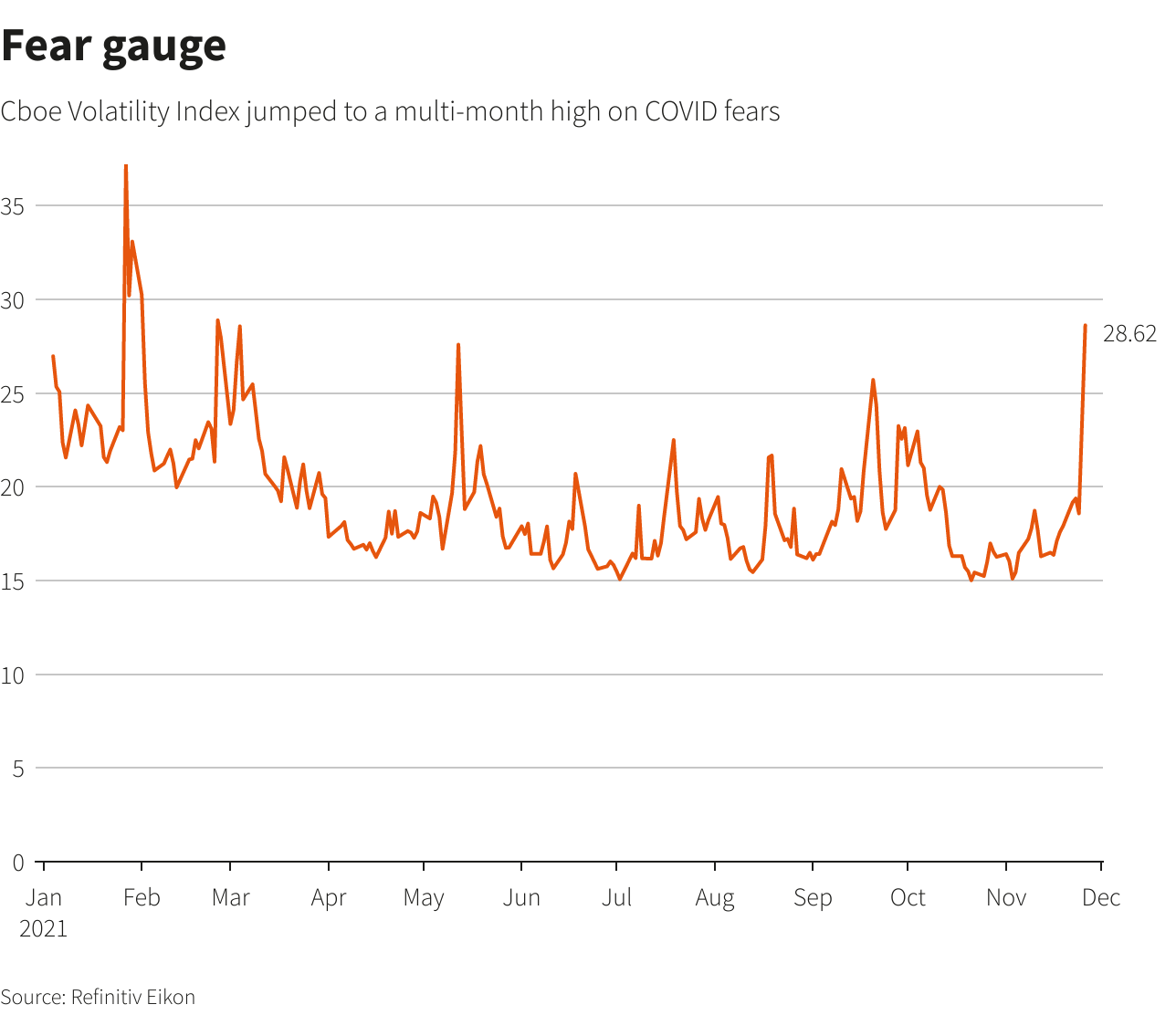The floor of the New York Stock Exchange (NYSE) is seen after the close of trading in New York, U.S., March 18, 2020. REUTERS/Lucas Jackson
Register now for FREE unlimited access to reuters.com
Register
NEW YORK, Nov 26 (Reuters) – COVID-19 has resurfaced as a worry for investors and a potential driver of big market moves after a new variant triggered alarm, long after the threat had receded in Wall Street’s eyes.
Worries about a new strain of the virus, named Omicron and classified by the World Health Organization as a variant of concern, slammed markets worldwide and dealt the S&P 500 index its biggest one-day percentage loss in nine months. The moves came a day after the U.S. Thanksgiving holiday when thin volume likely exacerbated the moves.
With little known about the new variant, longer term implications for U.S. assets were unclear. At least, investors said signs that the new strain is spreading and questions over its resistance to vaccines could weigh on the so-called reopening trade that has lifted markets at various times this year.
Register now for FREE unlimited access to reuters.com
Register
The new strain may also complicate the outlook for how aggressively the Federal Reserve normalizes monetary policy to fight inflation.
“Markets were celebrating the end of the pandemic. Slam. It isn’t over,” said David Kotok, chairman and chief investment officer at Cumberland Advisors. “All policy issues, meaning monetary policy, business trajectories, GDP growth estimates, leisure and hospitality recovery, the list goes on, are on hold.”
The S&P 500 fell by a third as pandemic fears mushroomed in early 2020, but has more than doubled in value since then, though the pandemic’s ebb and flow has driven sometimes-violent rotations in the types of stocks investors favor. The index is up more than 22% this year.
Before Friday, broader vaccine availability and advances in treatments made markets potentially less sensitive to COVID-19. The virus had dropped to a distant fifth in a list of so-called “tail risks” to the market in a recent survey of fund managers by BofA Global Research, with inflation and central bank hikes taking the top spots.
On Friday, however, technology and growth stocks that had prospered during last year’s so-called stay-at-home trade soared, including Zoom Communications (ZM.O), Netflix Inc (NFLX.O) and Peloton (PTON.O).
At the same time, stocks that had rallied this year on bets of economic reopening may suffer if virus fears grow. Energy, financials and other economically sensitive stocks tumbled on Friday, as did those of many travel-related companies such as airlines and hotels.
The new Omicron coronavirus variant spread further around the world on Sunday, with 13 cases found in the Netherlands and two each in Denmark and Australia, even as more countries tried to seal themselves off by imposing travel restrictions.
First discovered in South Africa, the new variant has now also been detected in Britain, Germany, Italy, the Netherlands, Denmark, Belgium, Botswana, Israel, Australia and Hong Kong. read more
Friday’s swings also sent the Cboe Volatility Index (.VIX), known as Wall Street’s fear gauge, soaring and options investors scrambling to hedge their portfolios against further market swings. read more

Andrew Thrasher, portfolio manager for The Financial Enhancement Group, had been concerned that recent gains in a handful of technology stocks with large weightings in the S&P 500, including Apple Inc (AAPL.O), Amazon.com Inc (AMZN.O), Microsoft Corp (MSFT.O), were masking weakness in the broader market.
“This set the kindling for sellers to push markets lower and the latest COVID news appears to have stoked that bearish flame,” he said.
Some investors said the latest COVID-19 related weakness could be a chance to buy stocks at comparatively lower levels, expecting the market to continue rapidly recovering from dips, a pattern that has marked its march to record highs this year.
“We’ve had numerous days when economic optimism collapses. Each of these optimism collapses were a good buying opportunity,” wrote Bill Smead, founder of Smead Capital Management, in a note to investors. Among the stocks he recommended were Occidental Petroleum (OXY.N) and Macerich Co (MAC.N), down 7.2% and 5.2% respectively on Friday.
One of several wild cards is whether virus-driven economic uncertainty will slow the Federal Reserve’s plans to normalize monetary policy, just as it has started unwinding its $120 billion a month bond buying program.
Futures on the U.S. federal funds rate, which track short-term interest rate expectations, on Friday showed investors rolling back their view of a sooner-than-expected rate increase.
Investors will be watching Fed Chair Jerome Powell and U.S. Treasury Secretary Janet Yellen’s appearance before Congress to discuss the government’s COVID response on Nov. 30 as well as U.S. employment numbers, due out next Friday.
Investors held out hope that markets could stabilize. Jack Ablin, chief investment officer at Cresset Capital Management, said moves may have been exaggerated by lack of liquidity on Friday, with many participants out for the Thanksgiving holiday.
“My first reaction is anything we are going to see today is overdone,” Ablin said.
Register now for FREE unlimited access to reuters.com
Register
Reporting by Saqib Iqbal Ahmed; Additional reporting by Chuck Mikolajczak, Megan Davies and Lewis Krauskopf; Writing by Ira Iosebashvili; Editing by Megan Davies, Richard Chang and Alexander Smith
Our Standards: The Thomson Reuters Trust Principles.
